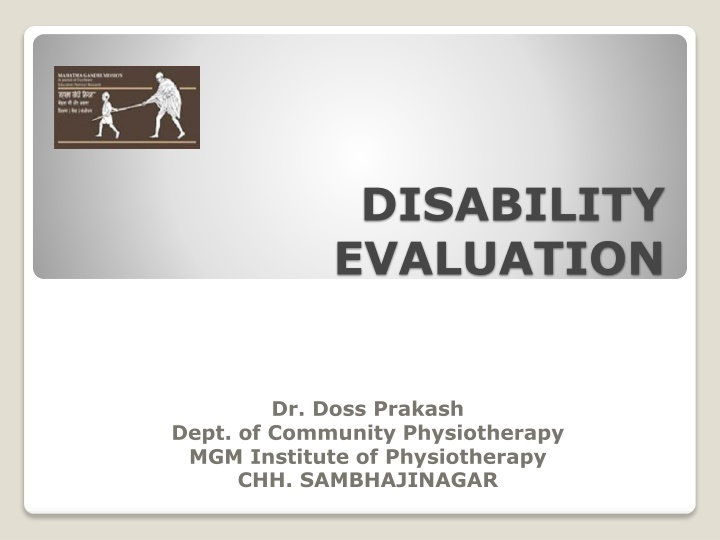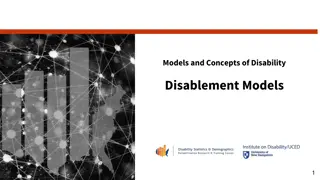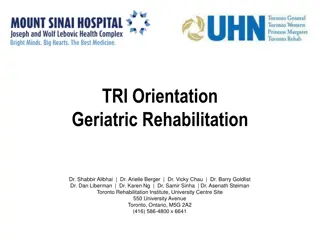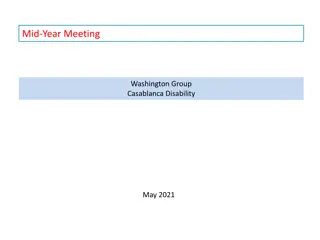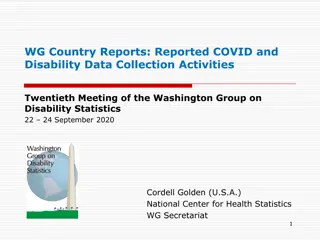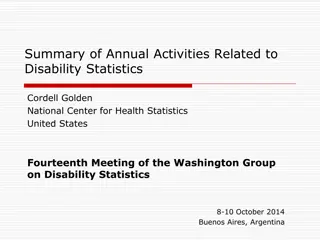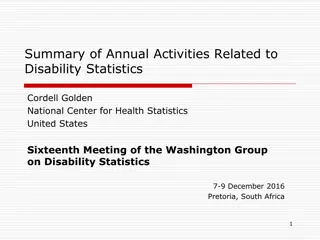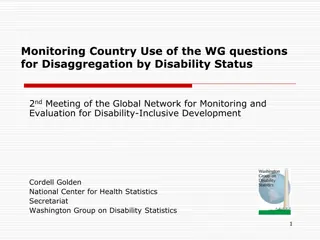DISABILITY EVALUATION
Disabled individuals are often overlooked and require structured, reliable, and valid evaluation methods for effective treatment and intervention. Follow guidelines from the Rights of Persons with Disabilities Act for evaluating various categories of disabilities like locomotor, visual, auditory, intellectual, and more. Understand the principles of disability evaluation and the importance of matching treatments to individual needs and outcomes. Explore the uses of disability evaluation in assessing patient needs, care levels, work performance, social integration, and more. Gain insights into the permanent physical impairment (PPI) disability assessment process and its significance in allocating resources effectively.
Download Presentation

Please find below an Image/Link to download the presentation.
The content on the website is provided AS IS for your information and personal use only. It may not be sold, licensed, or shared on other websites without obtaining consent from the author.If you encounter any issues during the download, it is possible that the publisher has removed the file from their server.
You are allowed to download the files provided on this website for personal or commercial use, subject to the condition that they are used lawfully. All files are the property of their respective owners.
The content on the website is provided AS IS for your information and personal use only. It may not be sold, licensed, or shared on other websites without obtaining consent from the author.
E N D
Presentation Transcript
DISABILITY EVALUATION Dr. Doss Prakash Dept. of Community Physiotherapy MGM Institute of Physiotherapy CHH. SAMBHAJINAGAR
Disabled people are not only the most deprived human beings in the developing world, they are also the most neglected.
Disability Evaluation Standard structured systematic and scientific methods of evaluating disability PRACTICAL, RELIABLE & VALID
Need for Disability Evaluation Matching treatments & intervention Measuring outcomes & effectiveness Identifying needs Setting priorities Allocating resources
Uses for Disability Evaluation Patient's need Outcome of the condition Level of care Work performance & social integeration Length of hospitalization Receipt of disability benefits
Principles of Disability Evaluation Functional Loss Individual Functional Requirement Personal Opinion Authority Testing Tools When to assess Validity of certificate
Section 56 of the Rights of Persons with Disabilities Act, 2016 (49 of 2016) Ministry of Social Justice & empowerment Ministry of Health & Family welfare Guidelines for disability evaluation
Categories Locomotor disability including cerebral palsy, leprosy cured, dwarfism, acid attack victims & muscular dystrophy; Blindness and low-vision; Deaf and hard of hearing and speech and language disability; Intellectual disability and specific learning disabilities; Mental illness; Chronic neurological conditions; Haemophilia, thalassemia and sickle cell disease; and Multiple disabilities.
Permanent Physical Impairment (PPI) Disability
LOCOMOTOR Disability Definition Locomotor disability means a person s inability to execute distinctive activities associated with movement of self and objects resulting from affliction of musculoskeletal or nervous system or both.
Guidelines for Evaluation of Permanent Physical Impairment (PPI) of Extremities Upper Extremity Lower Extremity
Guidelines for Evaluation of Permanent Physical Impairment (PPI) of Upper Extremities The estimation and measurement shall be made when the clinical condition has reached the stage improvement from the medical treatment. Normally the time period is to be decided by the medical doctor. The upper extremity is divided into two component parts; the arm component and the hand component. of maximum
ARM HAND Prehension Loss of ROM Muscle strength Coordinated activities Sensation Strength UPPER EXTREMITY
Guidelines for Evaluation of Permanent Physical Impairment (PPI) of Upper Extremities Measurement of loss of function of hand component consists of determining the prehension, sensation and strength. For estimation of prehension opposition, lateral pinch, cylindrical grasp, spherical grasp and hook grasp have to be assessed. The impairment of the entire extremity depends on the combination of the impairments of both components. Total disability % will not exceed 100%. Disability is to be certified as whole number and not as a fraction. Disability is to be certified in relation to that upper extremity.ity Lower Extremity
1. Loss of ROM The total value of maximum ROM in arm component 90% Shoulder 30% Elbow 30% Wrist 30%
Shoulder movements constitute 30% of the Motion of the Arm Component; therefore the loss of Motion for Arm Component will be 50 0.30 = 15%. If more one joint of the arm is involved the loss of the percentage is Calculated separately and added together
3. Coordinated activities 1. Lifting overhead objects remove and placing at the same place 9% 2. Touching nose with end of extremity 9% 3. Eating Indian Style 9% 4. Combing and Plaiting 9% 5. Putting on a shirt/kurta 9% 6. Ablution glass of water 9% 7. Drinking Glass of water 9% 8. Buttoning 9% 9 Tie Nara Dhoti9% 10. Writing 9%
Combining values of arm component
Example Let us assume that an individual with an intra articular fracture of bones of shoulder joint with a) 16.5% loss of Motion in Arm, b) 8.3% loss of Strength of muscles and c) 5% loss of coordination. These values should be combined as follow by using standard formula:
Loss of prehension 30% Loss of sensation 30% Loss of strength 30%
Combining values of upper extremity
MOBILITY STABILITY Loss of ROM 9 activities Muscle strength LOWER EXTREMITY
Combining values of mobility component
STABILITY COMPONENET STABILITY COMPONENT (Total Value 90%) Based on CLINICAL METHOD of Evaluation 1. Standing on both legs 10 2. Standing on affected leg 10 3. Walking on plain surface 10 4. Walking on slope 10 5. Climbing Stairs 10 6. Taking turns 10 7. Squatting on floor 10 8. Kneeling 10 9. Sitting Cross leg 10 Total 90 10% is given for complications like (i) Infection (ii) Deformity (iii) Loss of sensation.
